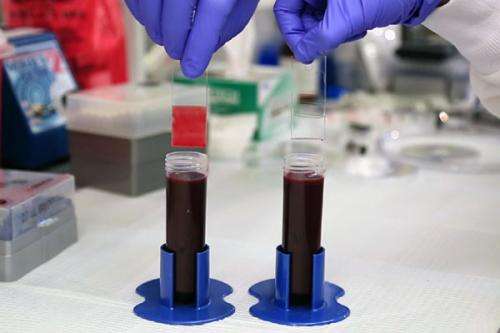Researchers collaborate on substance to repel blood clots and bacteria

Engineering a surface that is so slippery even geckos can't stick to it may sound like a fun science fair project.
But new surface-coating technology developed by materials science and engineering professor Ben Hatton, together with colleagues at Harvard University's Wyss Institute, does just that – and its slick properties have the potential to save lives.
Published recently in Nature Biotechnology, Hatton's innovative design prevents blood from clotting on medical devices such as catheters, dialysis equipment and heart-lung machines, which is a common problem and can be dangerous.
Blood clotting is an important process in your body, where platelets and proteins in the blood aggregate to seal a wound. However, blood also clots on foreign objects in the body, like catheter tubing, and this clotting can cause blockage of flow or blood clots flowing elsewhere in the body.
To counteract these negative effects, doctors and nurses often give patients blood thinners, but these medications can be difficult for those who are elderly, sick or severely wounded.
The problem is so significant it is sparking a number of innovative remedies – including award-winning work by Professor Paul Santerre on a method of infusing anti-clotting macromolecules into medical devices during the manufacturing process.
The new coating developed by Professor Hatton and his colleagues matches perfluorcarbons – a liquid that is chemically similar to Teflon – to a uniquely-engineered surface. The result is an ultra-low-adhesion, slippery material that repels blood, stopping the clotting process before it starts.
"Making an inert surface for blood contact is really a huge benefit for a wide range of medical procedures – we really just want blood to ignore that surface and not clot," said Professor Hatton in a recent CBC Radio Quirks & Quarks interview. (Listen here)
To demonstrate this, the research team tested the coating on over 20 different medical surfaces and with in vivo tests. The results were promising: much less blood clot formation for the eight-hour duration of the experiments, without the use of blood thinners.
In addition to blood, Hatton's technology has also shown to have profound antimicrobial applications – if liquids can't stick to it, it turns out bacteria have a hard time as well.
"Most antimicrobial materials function by releasing a chemical that kills bacteria on contact," said Hatton, explaining that some bacteria become resistant to these products.
"Our approach is different in that the surface of the material is just too slippery for bacteria to adhere to, so no chemical release may be needed."
Aside from blood and bacteria, the Harvard research team also brought a gecko into the lab to test the coating's slippery potential. The gecko – a creature whose footpads are known for their ability to scale smooth walls and stick to almost any material – was also unable to get a grip, sliding off when tilted.
"I think this is going to make everybody's life a whole lot easier in the medical community and for patients as well," said Professor Hatton. "Everyone but geckos, that is."
More information: "A bioinspired omniphobic surface coating on medical devices prevents thrombosis and biofouling." Nature Biotechnology 32, 1134–1140 (2014) DOI: 10.1038/nbt.3020


















